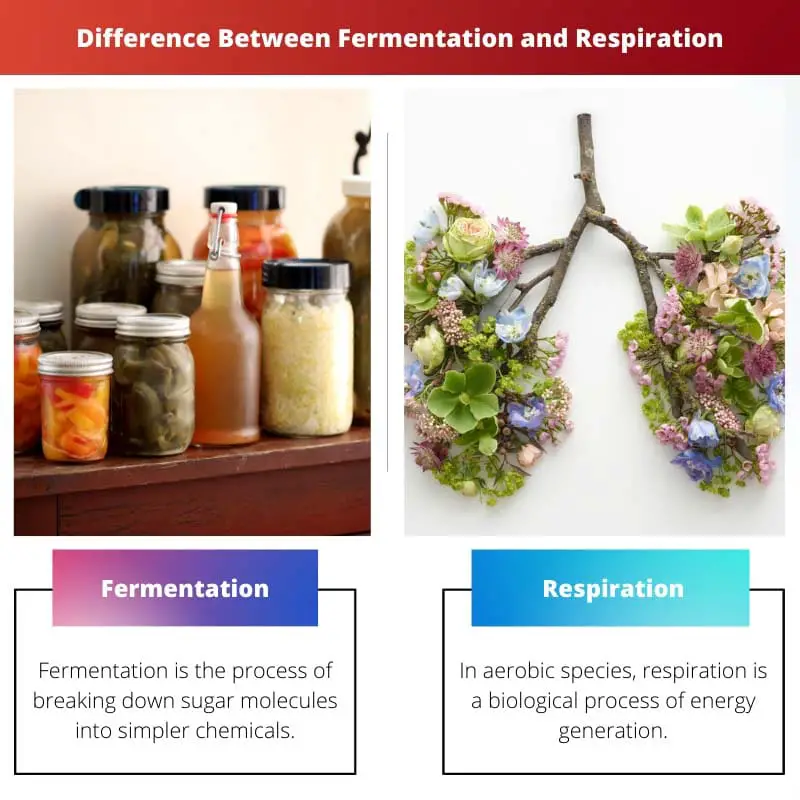Fermentation takes place in an anaerobic environment. As a result, glucose is largely converted to fizzy fatty acids during metabolism. When oxygen is available, the process of respiration creates energy from glucose.
Then, from one glucose molecule, fermentation and respiration create additional ATP. Moreover, respiration results in a full breakdown of the substrate, whereas fermentation results in a partial breakdown.
Key Takeaways
- Fermentation occurs in the absence of oxygen, while respiration requires oxygen.
- Respiration produces more ATP (energy) than fermentation.
- Fermentation generates end products like alcohol and lactic acid, whereas respiration produces carbon dioxide and water.
Fermentation vs Respiration
Fermentation is a metabolic process that converts organic compounds like sugars into simpler compounds. Respiration is a metabolic process that occurs in the presence of oxygen and involves the breakdown of organic compounds, such as glucose, to release energy in the form of ATP.

Fermentation is the process of breaking down sugar molecules into simpler chemicals that can be utilized to generate chemical energy. Chemical energy, in the form of ATP, is crucial because it powers a variety of biological functions.
Fermentation is anaerobic because it does not consume oxygen. The end products created from pyruvate or its derivatives differentiate many different forms of fermentation.
In aerobic species, respiration is a biological process of energy generation. It takes glucose as a substrate and generates 36 ATP molecules from a single glucose molecule. The production of energy through respiration necessitates the use of oxygen.
The three primary steps are glycolysis, Krebs cycle, and electron transport chain.
Comparison Table
| Parameters of Comparison | Fermentation | Respiration |
|---|---|---|
| Oxygen | Does not require oxygen. | Oxygen is essential. |
| Yet of ATP | Two ATPs. | 36 ATPs. |
| Types | Ethanol fermentation and lactic acid fermentation. | Aerobic and anaerobic respiration. |
| End Product | Ethanol and CO2 are produced in ethanol fermentation and lactic acid is the end product of lactic acid fermentation. | Carbon dioxide and water. |
| Contribution in creating energy | Contributes the least. | Contributes the most. |
What is Fermentation?
When it comes to fermentation, oxygen isn’t used. It consumes glucose and generates ATP as well as another molecule as a byproduct. There is less energy generated during fermentation than during respiration.
It receives its energy from glucose as well. Lactate bacteria are introduced to milk for it to ferment into yoghurt.
Lactate bacteria will subsequently ferment it. As a result, the end product is sour yoghurt. The technique may be modified in other goods, such as beer, by sealing the alcoholic beverage.
As a result, it will generate beer as its ultimate product at the end of fermentation. The same may be said about root beer. Ethanol and lactic acid fermentation are two forms of fermentation.
In the absence of oxygen, ethanol fermentation occurs in yeast. They’re known as facultative anaerobes because of this. Bacteria produce lactic acid. Animals create lactic acid mostly in their muscles when they are deprived of oxygen.
Lactic acid is a tissue irritant. For both fermentations, glycolysis is the same.
During glycolysis, glucose is broken down into two pyruvate molecules, producing two ATP molecules. Obtaining electrons from glyceraldehyde-3-phosphate results in the formation of two molecules of NADH.
Pyruvate is decarboxylated into acetaldehyde when carbon dioxide is removed during ethanol production. The hydrogen atoms of the NADH are used to convert acetaldehyde to ethanol.
The effervescence is caused by the cells in the medium producing carbon dioxide gas.
What is Respiration?
Respiration is a natural process that every form of life goes through to make energy by breaking down molecules inside the cell and using oxygen to do so. As we all know, ATP, or adenosine triphosphate, is the fundamental type of energy in cells.
The stored energy inside these cells is released and broken down as they break down and undergo respiration.
To do so, oxygen is required to liberate the energy that has been stored. Muscle contractions and impulse production are two more roles of cellular respiration.
The three phases of respiration are glycolysis, citric acid cycle, and electron transport chain. Glycolysis occurs in the cytoplasm of the cell, much like during fermentation.
The mitochondrial matrix receives the two pyruvate molecules generated during glycolysis. During oxidative decarboxylation, they release two carbon dioxide molecules, one from each, and form acetyl-CoA.
The citric acid cycle, known as the Krebs cycle, takes this acetyl-CoA.
A single glucose molecule is entirely oxidized into six carbon dioxide molecules throughout the citric acid cycle, yielding 2 GTPs, 6 NADH, and 2 FADH2.
During oxidative phosphorylation, which takes place in the inner mitochondrial membrane, this NADH and FADH2 are coupled with oxygen to produce ATP.
An electron transport chain, which is a series of electron carriers, moves electrons in NADH and FADH2 during oxidative phosphorylation.
Main Differences Between Fermentation and Respiration
- Fermentation does not need to use oxygen to carry out the process, whereas respiration does.
- The breakdown of a single glucose molecule creates just two ATPs in fermentation, but the breakdown of a single glucose molecule yields 36 ATPs in respiration.
- The two forms of fermentation found in organisms are ethanol fermentation and lactic acid fermentation, while the two types of respiration found in organisms are aerobic and anaerobic respiration.
- Both ethanol and CO2 are produced during ethanol production. Lactic acid fermentation results in the production of lactic acid, whereas respiration results in the production of inorganic end products such as carbon dioxide and water.
- On Earth, fermentation contributes the least to the creation of energy for cellular operations, whereas respiration contributes the most to the production of energy for cellular processes.




